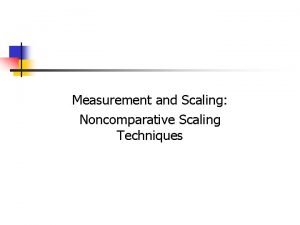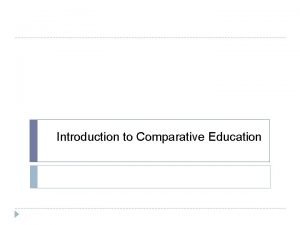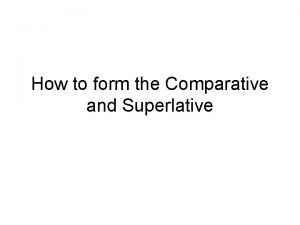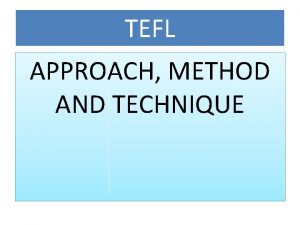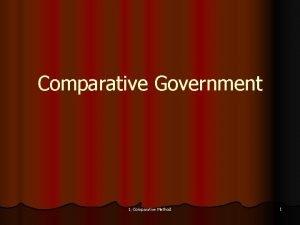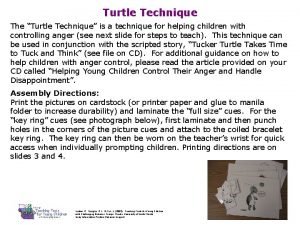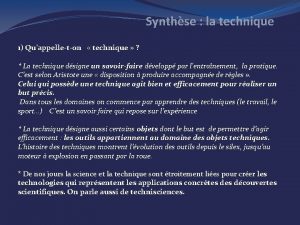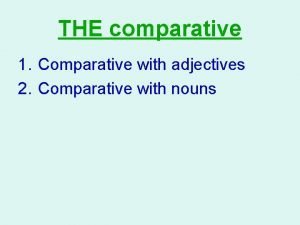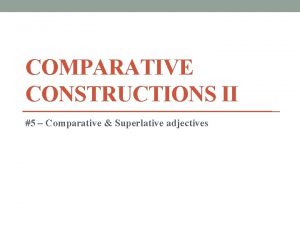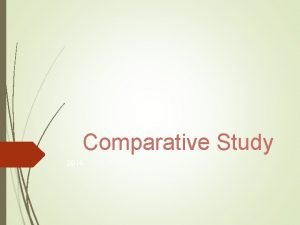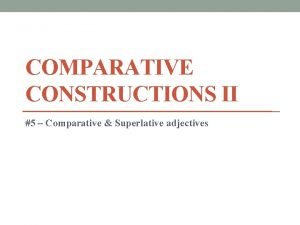Analogy Technique Chapter 11 1 Analogy Method Comparative








- Slides: 8

Analogy Technique Chapter 11 1

Analogy - Method • • • Comparative analysis of similar systems Adjust costs of an analogous system to estimate the new system Adjustments could be based on: – Programmatic information – Physical characteristics – Performance – Government vs. Commercial practices – Contract specifics – Economic trends $ $ 2

Description • Analogy estimates are usually characterized by use of a single historical data point serving as the basis for a cost estimate. • Use of this methodology is considered “risky” because the historical data is too limited to allow statistical estimating. • The analogy is an estimate based on a relative scaling of a historical data point. – New program cost = (scaling factor) x (old program cost) • The scaling factor should not simply be a point estimate, but rather a “most likely” range. – Provides uncertainty information. • The analogy technique is most useful when the new system is primarily a new combination of existing subsystems for which recent historical cost data are available. • Also useful in early milestone, ill-defined programs, and as a check on estimates used by other methods – relatively quick to do! 3

Analogy - Application • • • Used early in the program life cycle – Data is not available to support using more detailed methods – Not enough data exists for a number of similar systems, but can find cost data from a single similar system The best results are achieved when – Similarities between old and new systems are high – Adjustments can be quantified – Subjective adjustments are minimized Can be used as a cross check for other methods 4

How to Develop an Analogy • Using a known item’s value, apply quantified adjustments to that item which measure the differences when compared to the new. • This requires good actual data and someone to quantify the differences. • Recent historical data should be similar not only in performance characteristics, but also similar from the standpoint of manufacturing technology. • Questions to ask when assessing the relative differences between the old and the new item: – How much different is the new compared to the old? – What portion of the old is just like the new? – How many components will be exactly the same? – What is the ratio of complexity between the two systems? 5

Analogy Estimating Technique • Cost Estimating Method by which we assume our new system will behave “cost-wise” like a similar historical system • Define the new system in terms of: -- Design or Physical Parameters -- Performance Characteristics -- Known Similar System(s) • Develop a WBS for the New and Historical System • Map Historical System WBS to New System WBS so they look similar • Obtain Data on Historic System’s Design, Performance and Cost. -- CY$$? -- Learning Curve? -- Any burdens that need to be removed? 6

Utility of Analogy Technique • Many new programs consist of modified or improved versions of existing components, combined in a new way to meet a new need. • In the analogy technique we break the new system down into components (usually via a WBS) that can be compared to similar existing components. • The basis for comparison can be in terms of capabilities, size, weight, reliability, material composition, or a less well-defined, but often used, term, complexity. • When production and development cost estimates are needed, the analogy technique offers several approaches. – Separate development and production estimates, each based on data related specifically to development and production. – Production estimates based on production data, then use historical ratio factors to estimate development costs. 7

Analogy – It’s like one of these Attribute Old System New System Engine: Thrust: Cost: F-100 F-200 12, 000 lbs 16, 000 lbs $5. 2 M ? Q: What is the unit cost of the F-200? A: $5. 2 M * (16, 000/12, 000) = $6. 9 M Warning 1: An adjusted analogy is like a regression, but the slope is just a guess. Tip: The mischief in analogy most often arises in the adjustment. Why do we so readily believe a linear relationship on weight which passes through the origin? Warning 2: An adjusted analogy is, by definition, estimating outside the range of the data. 8

